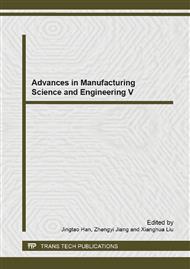p.662
p.666
p.670
p.676
p.680
p.684
p.690
p.696
p.703
Strength Analysis of Crankshaft Interfaces Considering Contact Problem
Abstract:
Since the work conditions of the crankshaft are complicated and the crankshaft interfaces are very weak, strength analysis of crankshaft interfaces is very important. Three dimensional finite element model of the crankshaft is built for strength analysis of the crankshaft interfaces. The crankshaft has three interfaces. During the analysis, contact problem is taken into account. The results show that the maximal stress of the crankshaft is 535MPa, which is less than the yield limit of 1Cr11Ni2W2MoV steel (993MPa). Therefore, the crankshaft interfaces can not be broken during the work of caterpillar tractor.
Info:
Periodical:
Pages:
680-683
Citation:
Online since:
June 2014
Authors:
Price:
Сopyright:
© 2014 Trans Tech Publications Ltd. All Rights Reserved
Share:
Citation:


